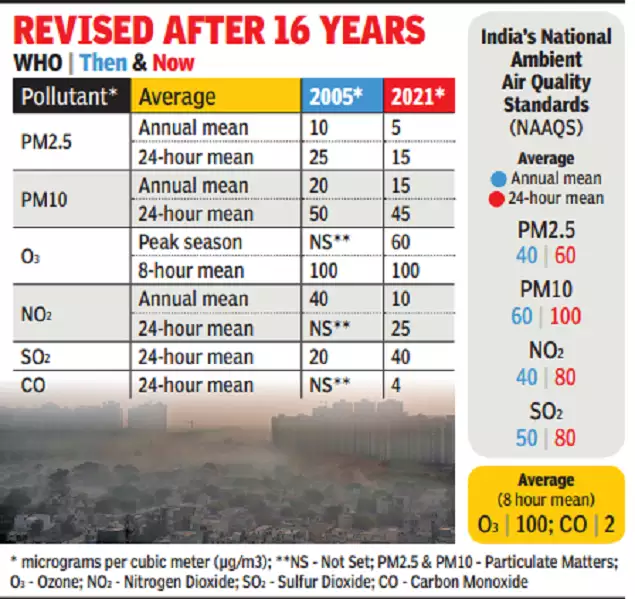Introduction:
Air pollution is one of the biggest environmental threats to human health, alongside climate change. Every year, exposure to air pollution is estimated to cause 7 million premature deaths and result in the loss of millions more healthy years of life. Improving air quality can enhance climate change mitigation efforts, while reducing emissions will in turn improve air quality.
“Air pollution is a threat to health in all countries, but it hits people in low- and middle-income countries the hardest,” said WHO Director-General, Dr Tedros Adhanom Ghebreyesus
key points of the revised Global Air Quality Guidelines (AQGs)
1. WHO’s new guidelines recommend air quality levels for 6 pollutants, where evidence has advanced the most on health effects from exposure. When action is taken on these so-called classical pollutants – particulate matter (PM), ozone (O₃), nitrogen dioxide (NO₂) sulfur dioxide (SO₂) and carbon monoxide (CO), it also has an impact on other damaging pollutants.
2. The health risks associated with particulate matter equal or smaller than 10 and 2.5 microns (µm) in diameter (PM₁₀ and PM₂.₅, respectively) are of particular public health relevance. Both PM₂.₅ and PM₁₀ are capable of penetrating deep into the lungs but PM₂.₅ can even enter the bloodstream, primarily resulting in cardiovascular and respiratory impacts, and also affecting other organs. PM is primarily generated by fuel combustion in different sectors, including transport, energy, households, industry, and from agriculture. In 2013, outdoor air pollution and particulate matter were classified as carcinogenic by WHO’s International Agency for Research on Cancer (IARC).
The guidelines also highlight good practices for the management of certain types of particulate matter (for example, black carbon/elemental carbon, ultrafine particles, particles originating from sand and dust storms) for which there is currently insufficient quantitative evidence to set air quality guideline levels. They are applicable to both outdoor and indoor environments globally, and cover all settings.
Almost 80% of deaths related to PM₂.₅ could be avoided in the world if the current air pollution levels were reduced to those proposed in the updated guideline, according to a rapid scenario analysis performed by WHO.
WHO’s New Global AQGs (2021) different from its last update 2005

Changes required in India’s National Clean Air Program (NCAP)
According to experts of Global Burden of Disease study, over 95% of India’s population already lived in areas where pollution levels were higher than WHO’s 2005 norms.
India’s own national air quality standards are much more lenient, even compared to WHO’s 2005 norms. For Example: The recommended PM2.5 concentration over a 24-hour period is 60 micrograms per cubic metre, compared to 25 micrograms advised by WHO’s 2005 guidelines. But even these lower standards are hardly met.
Impact of New Guidelines on India
The new air quality guidelines mean that nearly entire India would be considered a polluted zone for most of the year. However, by WHO’s own admission, more than 90% of the world’s population lived in areas which did not meet its 2005 pollution standards. The new WHO norms should push India to work harder to make its air cleaner and safer.
Further, the feasibility of implementing the new guidelines is questionable, especially in challenging geo-climatic zones like south Asia, including India. Experts point out that this region has challenging meteorological and climatic conditions, with the added challenge of haze columns, heat island effects and very high base pollution.
However, as the WHO’s guidelines are not binding, the move doesn’t immediately impact India as the National Ambient Air Quality Standards (NAAQS) don’t meet the WHO’s existing standards. The government has a dedicated National Clean Air Programme that aims for a 20% to 30% reduction in particulate matter concentrations by 2024 in 122 cities, keeping 2017 as the base year for the comparison of concentration.
CONCLUSION:
Given the condition of the Air Pollution in India, there is a need to strengthen health data and revise the National ambient air quality standards accordingly.
Extra Reading:
https://www.who.int/news/item/22-09-2021-new-who-global-air-quality-guidelines-aim-to-save-millions-of-lives-from-air-pollution